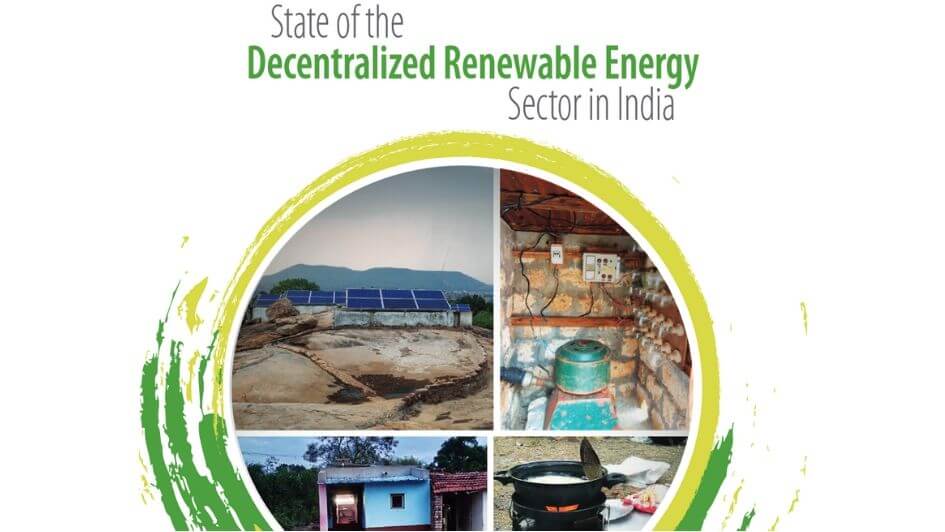A new report by Clean Energy Access Network (CLEAN) shows that the decentralized renewable energy (DRE) sector in India continues to see growth in enhancing energy access, especially in rural communities where it is experiencing maximum impact thereby aiding economic and social growth.
The report, an annual publication called the ‘State of the Decentralized Renewable Energy Sector’, further adds that the need for affordable and adaptable productive end-use of energy has not only sparked several innovative solutions such as solar dryers, freezers, sewing machines and other such applications that have had uptake in both rural and peri-urban markets, but also created new jobs and avenues for skills development in rural areas. However, there is a need for stronger regulation and policies in order for the sector to gain consumer acceptance that will facilitate further growth of the DRE market.
“Now in its third year, the report surveyed member organisations to assess the growth of the DRE sector in the country. It is aimed at serving as a benchmark for the sector to track ongoing performance and identify future needs. We have highlighted 28 impactful case studies from the sector, which indicate the sector’s expansion from energy access to development. With this shift in market moving from access to development, we anticipate that livelihoods and productive applications, energy-efficiency appliances, and clean cooking solutions and technologies will bolster the growth of the DRE sector in the coming years” says Adwait Joshi, Chief Executive Officer, CLEAN.
The report compiles current and emerging trends and perspectives from DRE enterprises, financiers, government representatives, researchers, experts, and funders. The key highlights of the report are:
Policy: There is a need for standardization, testing, and benchmarking to create increased awareness and acceptance among potential consumers of DRE systems and productive-use applications. In addition, a comprehensive mini-grid policy that explains the role and scope of mini-grid operators in partnership with the local utilities will help alleviate the current ambiguity in the sector. While the government’s LPG distribution initiatives have challenged the DRE sector, it has also opened up new, underserved regions for DRE businesses to grow.
Technology: DRE enterprises are adapting to the growing aspirations of consumers in previously energy-starved regions. The rise in community-based business models and innovations is supplementing an increase in productivity. Similarly, the growing demand for DC mini-grid applications is calling attention towards product standardization and fast turn-around times. Below table highlights the timeframe expectations for developing product standards:
Source: State of the Decentralized Renewable Energy Sector Report 2019, CLEAN
Finance: There is a need for a more conducive financial environment for DRE enterprises to flourish and help cater to the growing demand for affordable and reliable energy. The report found that 78 percent of enterprises surveyed had changed their business models as a result of government initiatives. About 45 percent reported profits in the last financial year, and 57 percent were able to raise capital. However, bridging access to finance remains a challenge, especially limited end-user financing, owing to lack of financiers’ exposure to the sector resulting in reluctance in investing. In addition, high interest rates and collateral for bank loans continue to hinder growth.
Jobs: The 42 CLEAN member enterprises who responded to the survey currently serve 43,00,000 customers and are responsible for 4344 full-time jobs and 2556 part-time jobs in the sector. A recent jobs census by Power for All reported the creation of 95,000 direct formal jobs and 210,000 informal jobs in 2017-2018. In order for the sector to grow, a standardized, accredited, industry-relevant curriculum through stronger collaboration between government, industry, and academia will be helpful, as well as the promotion of soft skills and rural micro-enterprise trainings to close the skills gap. There is a need to formalize informal labour in keeping with globally accepted standards, and to promote the participation of women in the sector.
SDGs: The report also highlights how DRE solutions can help advance the Sustainable Development Goals (SDGs) such as ending poverty, promoting good health and well-being, quality education, decent work and economic growth, and promoting low-emission, resilient development pathways.
The growth of India’s DRE sector is promising and is already an integral part of the supply solution. With a greater policy and regulatory push, the right financial instruments, and adequate community participation the DRE sector can help further development outcomes, along with a clean energy transition for the country.
